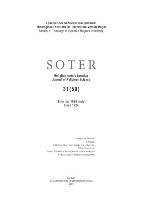Romuviečių vaidmuo jaunųjų katalikų sąjūdžio genezėje (1921–1933 m.)
THE ROLE OF ROMUVA ADHERENTS IN THE GENESIS OF YOUNG CATHOLICS’
Author(s): Ramūnas LabanauskasSubject(s): Christian Theology and Religion
Published by: Vytauto Didžiojo Universitetas
Keywords: Ateitininkų federacija; atranka; elitas; finansavimas; jaunųjų katalikų sąjūdis; ideologija; katalikai kultūrininkai; Katalikų veikimo centras; kultūrinė autonomija; Ateitininkai Federation; selection; elite; sponsorship; young Catholics’ movement
Summary/Abstract: Social, cultural and political activity of Romuva adherents was motivated by the ambition to implement ideas of Christian humanism as one of the variants of open Catholicism. Romuva adherents formulated their own political objectives in the document called “General ideology of political centre” prepared by the ateitininkai-old-friends lot headed by S. Šalkauskis. This “Political centre” programme was tried to perform practically taking place in Lithuanian Christian Democrats Party’s (LCDP) activity (trying to combine its engagement in Christian democracy with the principles of world-view freedom and national solidarity) and Catholic congresses where the Catholics were encouraged to flock round the Catholic Operation Canter. There was an intense activity in youth, abstinence, educational organizations. The initial point of the organization was directed to realize S. Šalkauskis’ concept of full life. From this point of view S. Šalkauskis and J. Eretas’ collaboration with the enthusiast of physical culture K. Dineika was significant. They developed the concept of full life together with other its devotees: Rev. M. Reinys and K. Paltarokas (later bishops). J. Eretas tried to embody the ideals of full life by reforming and modernizing Lithuanian Catholic youth organization “Pavasaris” (Spring). J. Eretas paid special attention to leader trainings. Romuva adherents furthered getting in touch with Catholic youth organizations from Western Europe. J. Eretas and K. Pakštas’ frequent scientific duty journeys served for that purpose. Their work in the philosophy department of Theology and Philosophy Faculty forming the movement of young Catholics was the most important. S. Šalkauskis and J. Eretas were very popular among the students, and it helped to spread their ideas among the young generations. High-scoring work of Romuva adherents in the faculty was hardly possible without the support of other Catholic-cultural figures such as the dean of the faculty P. Būčys, secretaries-prelates Rev. P. Kuraitis and Rev. M. Reinys, future Panevėžys bishop K. Paltarokas who was teaching sociology. The changes of political and church life circumstances in Lithuania in 1926-1927, especially elimination of Christian Democrats from the reign and the appointment of new bishops, made more active Catholic cultural figures’ camp. According to the information presented by J. Eretas, after the revolution, Catholic elite group of the highest hierarchies (bishop K. Paltarokas and M. Reinys), the most famous Catholic science representatives (S. Šalkauskis, J. Eretas, K. Pakštas, prelate P. Kuraitis) and Catholic youth elite (“Fraternity of Jakšto street”) was formed. This group was meeting regularly in prelate Kuraitis’ fat and it was strictly defined and consisted of an exact number of people (15 members) and partially institutionalized (members were co-opted). It can be possible that Romuva members considered this group as the descendants of Romuva society restored by S. Šalk
Journal: SOTER: religijos mokslo žurnalas
- Issue Year: 59/2009
- Issue No: 31
- Page Range: 169-187
- Page Count: 19
- Language: Lithuanian

